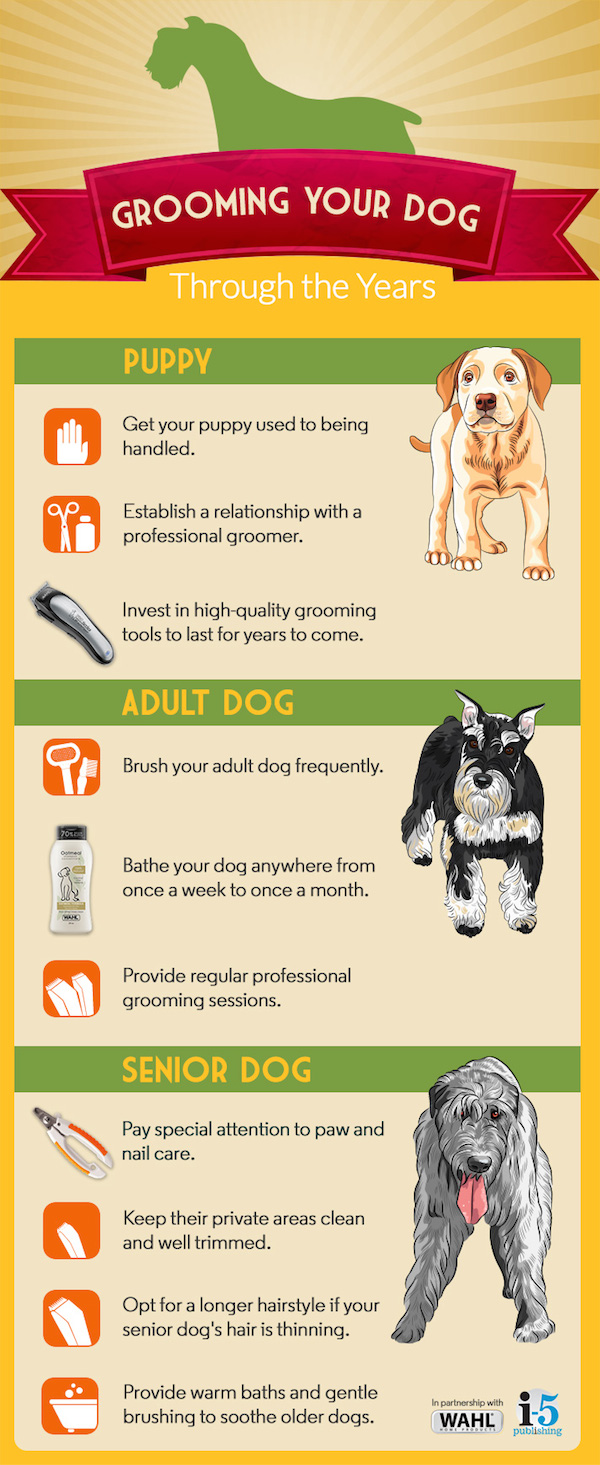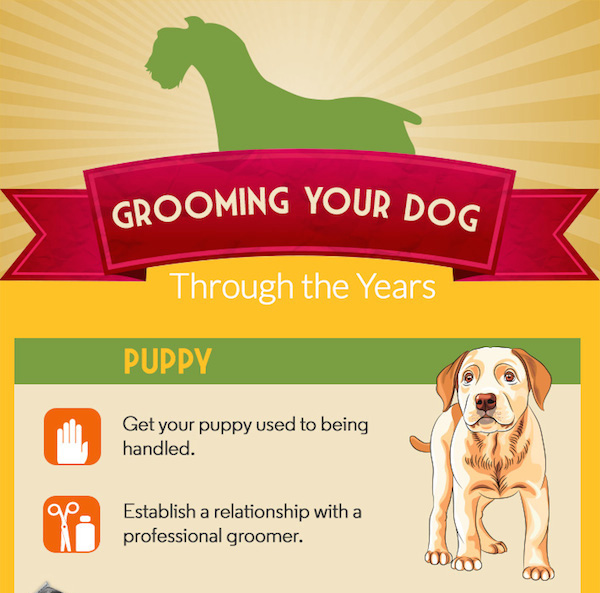Sponsored by:

Proper grooming is an essential part of caring for your dog. Throughout your dog’s life, brushing and bathing will help keep his coat in good condition, but his exact grooming needs will change as he grows from a puppy to an adult to a senior. Here’s what you can do to make sure your canine companion is getting the care he needs at each life stage.

Puppy Grooming Needs
When puppies are born they are covered in what is referred to as a “puppy coat.” Generally somewhat shorter than what the adult coat will be, the puppy coat tends to be a little on the fluffy side, is fine and lacks undercoat. It keeps puppies warm and protects them from the elements as they move from the whelping box out into the world. Depending on the breed and coat type, your puppy’s hair will begin to transition to an adult coat somewhere around the age of 6 months. One hallmark of the puppy coat is that it does not tend to mat and tangle as much as the coat of an adult dog can. Yet, training your new little companion to be groomed even before much coat-care is required is a great idea.
No matter if your dog has a sleek, smooth coat like a Boxer, or long flowing locks like a Shih Tzu, he will need to become accustomed to the sights, sounds and sensations of grooming. Talk to your pet’s breeder, your groomer or other knowledgeable people to find out what type of grooming tools will work best for your dog’s coat type, and then in invest in high-quality grooming tools, as these should last for many years if properly cared for. Allow your puppy to see and smell the tools, and gently introduce him to the sensation of having his coat brushed and combed.
Keep your first grooming sessions short and upbeat, giving your puppy small, high-value treats to reward good behavior, and always end on a high note.
Once your puppy is comfortable with being handled, it’s time for a professional groom. When people bring their dog to a professional pet stylist, they often ask for a “puppy cut.” This little term can actually cover a wide variety of looks, depending on the breed and coat type. In general the term refers to clipping the pet’s hair so that it is a uniform length all over. That length may vary from a quarter inch to 4 or more inches, depending on the breed and the owner’s personal preference. In the Poodle world, a “puppy cut” refers to a very specific style that show dogs sport before they are 1 year old.
To help your groomer better understand the look you’d like your pet to sport, bring in some photographs from books, magazines or the Internet. Your groomer will want to know how long you wish the hair to be on the pet’s body as well. Good pet groomers will take time to talk to you and understand the trim you want. They may have to offer alternative suggestions if your dog’s coat will not be able to achieve your desired style due to coat texture or condition. For example, if your long-haired dog has developed mats and tangles close to the skin that you cannot feel, the groomer may have to clip the coat very short to humanely remove the tangles. Once that is done, you and your groomer can work together to get on a regular grooming schedule and grow your pet’s coat out to the look you find most appealing.
Adult Dog Grooming Needs
For adult dogs, it’s all about maintenance. Grooming needs for adult dogs will vary depending on the breed, coat type and how much maintenance you are willing to do between visits with a professional groomer.
In general, frequent brushing sessions with appropriate grooming tools are a good idea because they help remove loose coat, dust and dander, as well as prevent tangles. You’ll also need to regularly bathe your dog.
Many pet owners wonder how often their pet should be bathed. If high-quality shampoos and conditioners made specifically for dogs are used, there is no reason a pet cannot be bathed as often as every week if it is required. For example, I share my heart and home with Flirt, a cream-colored Toy Poodle. We live on a mini farm, and Flirt, despite her fluffy appearance, is not above rolling in… well, anything! So she gets a bath about every week or 10 days, depending on how grubby she gets. I also have a smooth-coated Black Mouth Cur. Her hard coat stays clean, sleek and does not hold odor, so she only gets a bath every month or so. In general, if your pet’s coat does not feel or smell nice, a bath is in order.
If you are bathing your pet at home, make sure you rinse completely, then rinse again. Shampoo residue left behind can attract dirt, cause matting or even irritate the skin. If your dog has dry and itchy skin, you can try an oatmeal shampoo, like this one from Wahl. If you have a long-haired dog, make sure to brush and comb him out completely after the bath. Failing to do so can actually encourage mats and tangles to form. You need to be able to get a good metal comb from the skin to the tips of the hair, all over the pet’s body.
In between baths, you can use pet wipes or waterless shampoo to keep your dog clean. With Wahl’s No-Rinse Waterless Shampoo, you simply distribute the foam through your dog’s fur and then towel or brush the pet off. No muss, no fuss!
Senior Dog Grooming Needs
As your adult dog ages, you may find that more frequent grooming sessions are needed to keep him clean and tidy. Special attention to paw and nail care, as well as keeping the “private” area clean and well-trimmed can be helpful for the senior set. A warm bath and gentle brushing can also be very soothing to older dogs who might be suffering from arthritis. In some dogs, their fur becomes thinner as they age; sometimes a slightly longer hairstyle helps them maintain the fluffier look they sported in their younger years.
From bouncy pups to dignified senior citizens, each life stage requires some form of regular grooming. Keeping your dog well-groomed throughout his life helps keep him healthy, and helps keep him looking and smelling wonderful.
Sponsored by:





